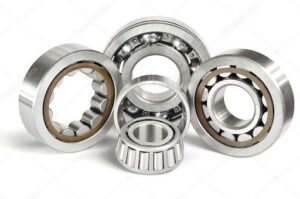Whether you’re running industrial machinery or maintaining a vehicle, reducing friction and increasing efficiency is always the goal. One component that makes this possible is the roller ball bearing. It might be small in size, but it plays a big role in keeping machines moving smoothly, quietly, and reliably.
Roller ball bearings are commonly found in engines, gearboxes, motors, and a wide range of industrial and automotive applications. Designed to support rotating parts and minimize wear and tear, these bearings are essential to ensure long-term mechanical health.

What Is a Roller Ball Bearing?
A roller ball bearing is a type of bearing that uses rolling elements—typically steel balls or rollers—to support radial and axial loads. These rolling elements sit between two smooth surfaces called races, allowing them to rotate with minimal friction. The result? Less energy loss, less heat, and more consistent performance.
Unlike plain bearings, roller ball bearings don’t rely on lubrication alone to manage movement. Their rolling action makes them perfect for high-speed and high-load conditions, which is why they’re widely used in everything from bicycles to industrial conveyor systems.
Key Benefits of Roller Ball Bearings
Here are some reasons why roller ball bearings are essential:
Low Friction: Reduces energy loss and improves efficiency
Durability: Built to last under heavy loads and extreme conditions
Smooth Operation: Ensures noise-free and vibration-free movement
Wide Compatibility: Available in various sizes and types for different machinery
Cost-Effective: Prevents wear on expensive components, reducing maintenance costs
Using a roller ball bearing of the right type and size can significantly extend the life of your equipment while keeping maintenance to a minimum.
Types of Roller Ball Bearings
There are several types of roller ball bearings depending on the application, such as:
Deep Groove Ball Bearings: Most commonly used in electric motors and gearboxes
Tapered Roller Bearings: Ideal for handling both radial and axial loads, often seen in vehicles
Spherical Roller Bearings: Designed to manage misalignment in heavy-duty machinery
Cylindrical Roller Bearings: Best for high-speed applications in motors and pumps
Each type is engineered for specific uses, so choosing the correct one matters for performance and safety.
Common Applications
You’ll find roller ball bearings in almost every mechanical system. Some common use cases include:
Automobiles (wheels, transmissions, alternators)
Industrial machinery (motors, fans, compressors)
Agricultural equipment (tractors, harvesters)
Power tools (drills, saws, grinders)
Household appliances (washing machines, refrigerators)
Their ability to operate under high speeds and various load conditions makes them a top choice in engineering.
Choosing the Right Bearing for Your Needs
When selecting a bearing, consider these key factors:
Load type (radial, axial, or both)
Rotational speed
Operating environment (temperature, moisture, dust)
Fitment size and tolerances
Also, look for trusted brands and verified suppliers that offer quality assurance. Poor-quality bearings can fail quickly, costing more in downtime and repairs.
Final Thoughts
In any mechanical system, every part plays a role—but some are more critical than others. The roller ball bearing is one such part. It reduces wear, supports rotation, and keeps your systems working smoothly. Whether you’re building, repairing, or upgrading a machine, investing in the right bearing is a smart move.
So, next time your project calls for durability, reliability, and precision—consider a high-quality roller ball bearing.